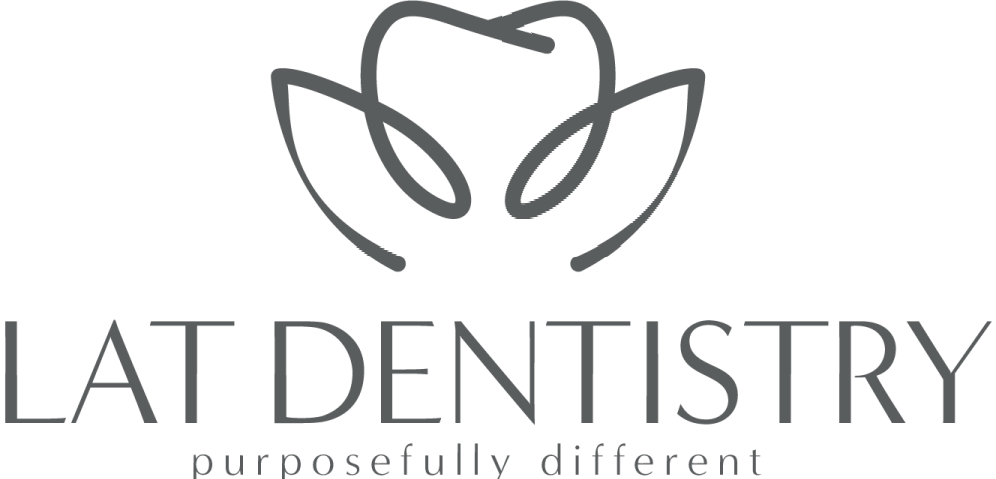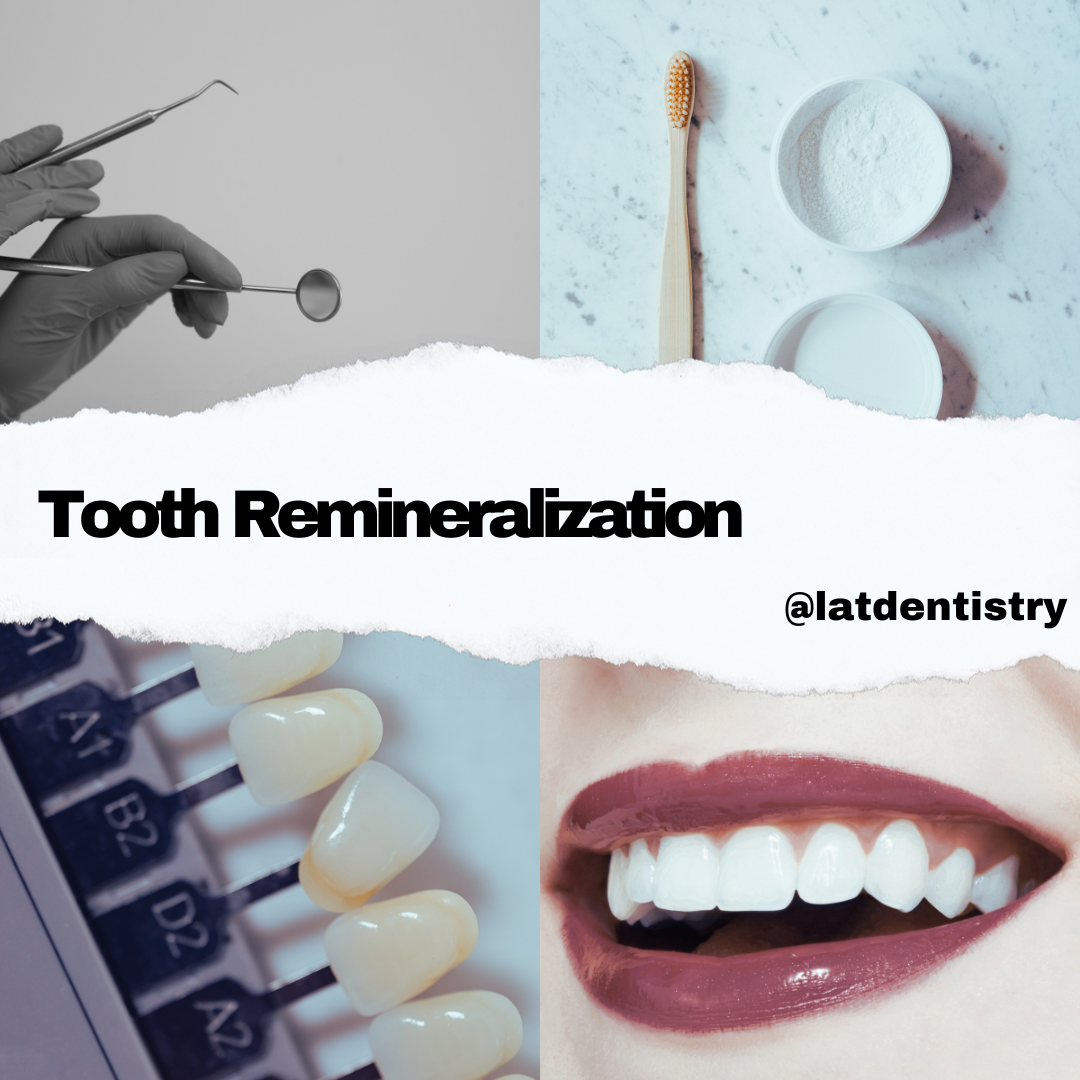Remineralization
Let’s talk evidence, products, and limitations
We get asked frequently about remineralization options to prevent, treat or reverse cavities. So, let’s dive into this topic!
Teeth are composed of several layers: enamel (the white, hard portion of the tooth), dentin (the yellow, soft interior of the tooth), pulp (the nerve of the tooth), and cementum (soft coating on the root of the tooth). These layers of tooth are constantly going through a process of mineral loss and gain, an equilibrium. Minerals are lost throughout the day during periods of acidity from food, drinks and dryness, and minerals are gained back from the saliva. Net mineral loss is called DEMINERALIZATION, which leads to cavities; net mineral gain is called REMINERALIZATION, and prevents or in some cases stops cavities in their tracks.
It is well understood that cavities in enamel and root surfaces can be remineralized. This is because these areas are 1) accessible to products 2) have residual site for new minerals to attach (nucleation sites) 3) have little organic (collagen) components. The inner surface of the tooth, dentin, CANNOT currently be reliably remineralized. This is because the crystals the make up the enamel and dentin have an arrangement opposite to one another that prevents these remineralization products from penetrating or reaching the deepest part of the cavity. It is also because the dentin has a much higher concentration of collagen as well as no great areas for minerals to attach or nucleate.
It is very important to understand that there are NO RELIABLE WAYS to remineralize cavities that have gone beyond the enamel layer of the tooth! Don’t risk your health or your child’s health by attempting techniques suggested by non-validated sources such as social media, friend groups, etc. Trauma from tooth pain and infection can often be life-long, and bad bacteria left in the mouth can lead to major whole body health problems. However, the future remains bright and the possibility of true biomimetic remineralization of deeper dentin cavities remains possible, but not currently available.
Healthy saliva flow is extremely important for the remineralization process. This is why when we discuss cavity risk with new patients, we often start with discussions of diet and medications. It is very important to eat a balanced diet with plenty of vegetables and stay hydrated with PLAIN, FLAT water to keep saliva flowing! Many medications on the market reduce saliva flow, so staying healthy to limit medication use is beneficial to prevent cavities. For many people, the simplest and cheapest way to prevent cavities is by eating a healthy diet of fresh vegetables and limiting processed food intake.
Products:
Fluoride:
Kills bacteria, prevent new bacteria from growing, incorporates into the enamel of the tooth requiring more acidity to reach net demineralization (prevent mineral loss)
Large body of evidence showing efficacy in remineralizing cavities on root surfaces and preventing initial cavity formation
Many families what to understand alternatives to fluoride containing products
Metals like Silver and Tin
Often other metals combined with fluoride have shown increased efficacy in remineralization
Silver in combination with fluoride (SDF) has been shown to be very effective in remineralizing and stopping cavities in enamel and on root surfaces
An alternative to SDF is Silver Nitrate, which has a growing body of evidence showing similar efficacy as SDF
Stannous fluoride (fluoride combined with tin), has been shown disrupt formation of the cavity-forming types of bacteria, and it sit on the tooth surface acting as a barrier to acid attack.
Calcium, Phosphate (together, known as hydroxyapatite)
Has been studied for over 20 years for remineralization potential in enamel and root surface cavities
Comes if many varieties such as: bound to casein / milk protein casein phosphopeptide-amorphous calcium phosphate CPP-ACP, functionalized beta tricalcium phosphate, bioactive glass containing calcium sodium phosphosilicate CSPS, sodium trimetaphosphate TMP
Xylitol
This is a sugar alcohol that kills bacteria when they try to digest it
Shows limited evidence of remineralization of enamel when used in high concentrations, such as 1 gram or 20%+
Arginine
Arginine is an amino acid that alters the biofilm, ie: the types of bacteria living in the mouth and how they alter acidity in the mouth
It is broken down by healthy oral bacteria into ammonia, which helps combat acidity generated by pathogenic bacteria
Boasts a sufficiently large body of evidence showing increased ability to stop cavities in enamel and on root surfaces in combo with phosphate and other ions
Proanthocyanidins
Found in fruits such as blueberries and cranberries, these compounds have early evidence showing synergistic effects when in combo with calcium-phosphate compounds
Self-assembling peptides
Minerals like calcium and phosphate need places on the tooth to attach, or nucleate, and self-assembling peptides such as P11-4 have shown promising results to provide these attachment points and allows for faster and possibly deeper sites of remineralization
Silver
Antimicrobial, comes in several forms such as silver nanoparticles, silver diamine fluoride, silver nitrate
Iontophosphoresis
Uses a low electrical current to force minerals into the tooth and allow deeper remineralization
Study limitations: most studies of remineralization therapies pit the product against traditional fluoride containing compounds as fluoride has been so highly studied and validated in the process of cavity prevention and remineralization. Further, many studies available are sponsored by the companies developing the products, which make them inherently biased. Therefore, it is important to be aware of the limitations of comparing, contrasting and recommending some of these newer therapies.
Plaque and biofilm modification
It is important to understand that incorporating biofilm modifiers plays an important role in cavity prevention. This involves good home care routine with mechanical brushing and flossing. Oil pulling can have positive benefits as well when used with a thorough flossing routine. Oral probiotics will promote healthy oral bacteria while antimicrobials such as silver, fluoride, tin, and many rinses on the market will kill bacteria. Ozone is another highly effective antimicrobial agent, as effective as bleach, with less cellular toxicity. However, gaseous ozone does generate reactive oxygen species, and can be harmful to the lungs and other organs. It has been reported that ozone can penetrate up to 1 mm into a cavity to kill bacteria, so it may be an effective pre-treatment for enamel and root surface cavities prior to remineralization therapies. Ozonated water can remain stable for 2 days and ozonated oils can remain stable for up to 2 years under specific conditions such as refrigeration and proper capping, so it is important to be cautious when attempting to source products.
In summary, remineralization is an important part of a healthy mouth. At LAT Dentistry, we educate our patients on the important of remineralization in their oral health, weather through diet, products, or both. We also want our patients to be aware of the possibilities as well as limitations of what is currently on the market. Often, marketing of health products can be an industry with limited regulation and oversight, and unfounded claims do exist. We recommend cautiously optimistic consumer activity and regular visits to your healthcare provider to discuss your goals and current risk factors.

